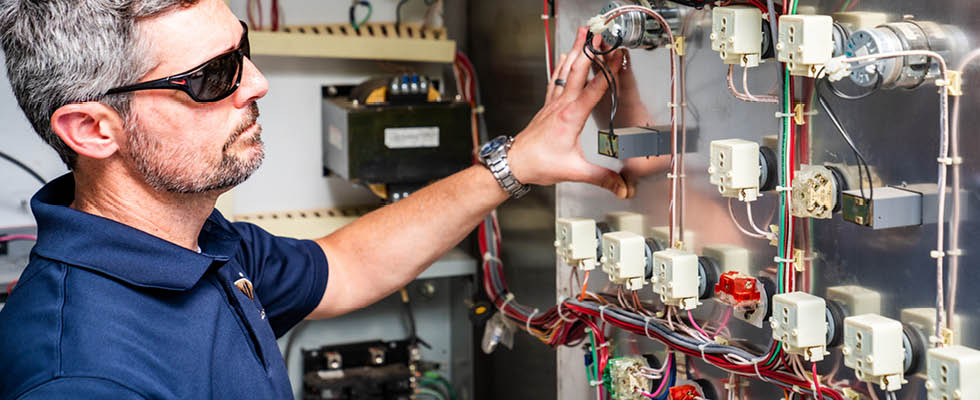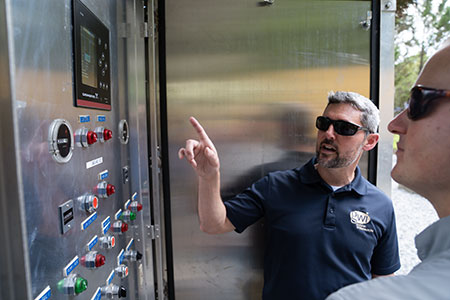
What is the key to getting the most out of pumping equipment? The answer may not always be to purchase the latest pump on the market or upgrade to the newest impeller model. Instead, this issue may be solved by optimizing the external components responsible for controlling and monitoring.

A large percentage of pumping systems across all industries are operating below their intended efficiency point, and some are even on the brink of failure. Pumping conditions are not always what they are during lab testing, so when a pump gets installed in the field, many factors can cause it to operate away from the design point. But how can these anomalies be identified without knowing what to look for or having a means for detection and prevention?
Pumping stations are full of hidden operational data that can tell a great deal about the overall condition of the system (hydraulics, piping, valves, motor, wet well, etc.). Without a way to access this data, it can be difficult to understand true reasons for, or notice signs of, improper operation that can lead to unplanned maintenance or even sudden failures. The good news is that by making some minor changes and following simple practices around automation and remote monitoring, the overall efficiency of a system can be improved for only a fraction of the cost to repair or replace a pump.
Many municipalities spend hundreds of thousands of dollars on new pumping equipment each year. They might even spend the same amount, or more, in labor and parts to keep troublesome stations operating. Having a smart control system and an easy way to monitor stations remotely can increase the life span of the pumping equipment and reduce the average maintenance cost throughout.
Unfortunately, controls and remote monitoring products are often seen as being secondary, but when used correctly, they can ultimately have a great impact on improving efficiency and preventing critical failures. Digital solutions are the way of unlocking hidden data and using it to keep a system running as designed. Many end users in the water and wastewater industry still operate their pumping systems on relay logic panels without any remote visibility. Some operators still travel station to station daily to manually jot down operating hours in paper spreadsheets.
This strategy is problematic for multiple reasons. Troubleshooting these panels can be extremely time-consuming, and they are often altered in the field to bypass recurring faults. This violates ratings and safety protocols while also making it nearly impossible to reference the original drawings when troubleshooting down the road. There is typically no backup when these systems fail, so the objective is to get them back up and running at all costs.
Not only does it take a great deal of time and money to have someone physically travel to each station, but record keeping is susceptible to human error, and there is usually no way to analyze the handwritten data taken at each station. It becomes expensive, time-consuming and unsafe to keep these systems up and running. Some minor upgrades to these types of control systems can improve the overall performance and day-to-day operations for technicians. If a complete upgrade to the control system is not an option, there are still ways companies can enhance performance and visibility at a reasonable cost.

When designing a new pump station and control system, the end user or engineer should always design it around a pump controller (programmable logic controller [PLC] or preprogrammed pump controller). These components can easily be implemented into a new or existing system and typically allow for future expansion.
They also reduce the time required for troubleshooting or manually collecting data. Paying an additional 10% to 20% on the initial pump investment to include a smart pump controller will reduce the operational expenditure (opex) costs required to maintain a cheaper relay logic alternative. In general, a controller solution can be included for around $1,200 to $5,000, depending on the complexity desired. Some more advanced PLC systems may cost upwards of $10,000 and may not be required to achieve the most effective functionality. Preprogrammed pump controllers typically fall within the $1,200 to $3,500 range and can cover over 90% of needs with preprogrammed functions.
Pump controllers can monitor hundreds of different parameters, while a basic relay panel may only account for a handful of measurements. Preset functions can be enabled on pump controllers to help maintain and improve pump operation locally at the station. Many pump controllers have the following built-in features to help protect the pumping equipment and prevent critical events at the station:
- grouping and alternation for multiple pumps (some controllers can control as many as six to nine pumps by default)
- seal leak and overtemp detection
- alarm notifications and data logging
- pump and alarm setpoint configuration
- flow calculation
- scheduled runtimes
- clog detection and pump reversal
- energy optimization
- overflow detection
- station cleanout
- variable frequency drive (VFD) functionality
- supervisory control and data acquisition (SCADA) integration
Another of the many benefits of a pre-engineered pump controller is the user can easily configure advanced functions without an extensive background in controls or automation. These out-of-the-box pump controllers can be as simple or as custom as the user needs, and they can be used for just about any pumping application. Once the pump controller is in place, it is easy to retrieve the hidden data at each station.
A wide range of sensors can be connected to a pump controller to make the system smarter and safer. It is recommended the following devices be included to get the full potential out of a control system:
- analog level sensor (submersible pressure transducer, radar, ultrasonic)
- power monitor
- variable speed drive
- backup level control (for redundancy)
- battery backup
- surge protection
- remote telemetry
These devices will increase the number of data points that can be monitored at each station, cut energy costs, enhance troubleshooting capabilities, protect the system, ensure continuous operation and provide remote visibility around the clock. The return on investment (ROI) for this technology is typically less than one month for end users that are having weekly callouts to troublesome stations.

After many years of struggling to keep up with endless callouts requiring site visits after hours, a municipality outside of Atlanta, Georgia, recently upgraded its 36 monitoring and control systems from relay logic, PLCs and an outdated SCADA system to an out-of-the-box pump controller and web-based SCADA. Due to the outdated controls and limited visibility via remote telemetry, thousands of dollars were being spent each week to send someone out to bypass stations to repair or replace faulty pumping equipment. After only weeks of operation, the new control and monitoring system remarkably cut back on callouts due to pump failures. The predefined software on the controller keeps the system running more smoothly than before, and important parameters such as level, flow, energy consumption, runtimes, alarms and warnings can all be viewed remotely from phones or laptops.
A recent power surge caused an input/output (I/O) board in one of the municipality’s panels to fail. Something that would have taken a week to troubleshoot and replace was easily identified via the detailed alarm notification and supporting data in their software, and the board was replaced within 24 hours.
This saved the municipality around $1,000 and cut back on time that would have been spent troubleshooting. For this municipality, having a reliable monitoring and control system has freed up time and money for more useful projects, as well as given the staff peace of mind that their pumping network is operating efficiently and is protected 24/7. By making small changes in the field to gather data from its pump stations, the municipality has made big improvements to its everyday operations.


